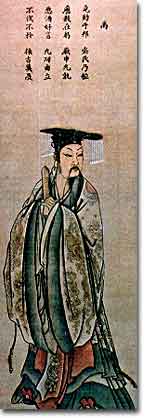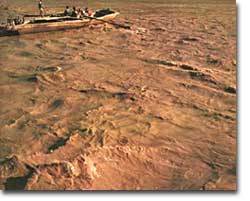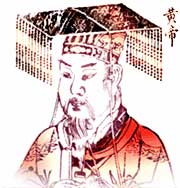9a. The Middle Kingdom

To prevent flooding of the north China plain by the Yellow River, Yu the Great organized large-scale projects in irrigation and dike-building. Yu then went on to found the first dynasty of China, the Xia.
From the misty veil of prehistory emerged the myths of ancient China. Heroes turned to gods, and men and beasts performed miraculous feats. Their myths explain the discoveries of the tools and practices used by the Chinese to the present-day.
Yet Chinese mythology has never contained any clear-cut creation stories. The people of China existed long before creation myths became popular. Instead, the earliest Chinese myths center on issues that everyday people had to face. One example involves a man named Yu.
The Legend of Yu
Flooding worried Emperor Shun. The Yellow River and its springs had overflowed, destroying farmland and putting people in danger. So the emperor consulted his advisors to find a way to stop the flooding. They all agreed that a man by the name of Yu, who could transform into a dragon or a bear, was the only one who could succeed where others had failed.
Yu's own father, Kun, had tried for ten years to build dams and dig ditches without success, the waters always overflowing any attempts to tame them. Upon the emperor's request, Yu came up with a plan. Yu knew that in Heaven there was a special "swelling soil" that multiplied when it touched water. He humbly asked the gods for the soil, and received it with their blessings. With the help of a winged dragon, Yu flew all over the land, using the soil to plug 250,000 springs, the sources of the water.
That problem solved, Yu turned his attention to the Yellow River and the flood waters that still remained. Amazingly, the solution came not from the mind of Yu, but in the form of a map on the back of a tortoise shell. Using the map, and later the help of the gods, Yu and his dragon were able to dig irrigation ditches that finally diverted the water off the farmland and saved the day. As a reward for his diligence, upon the death of Shun, Yu the Great became the first emperor of the Xia dynasty.

The Real Xia
Although the myths of Yu and others made great stories, for centuries they had no archaeological evidence to support them. So what is actually known about ancient China? Until 1928 when archaeologists excavated a site at Anyang in the Henan Province of China, no one knew what parts, if any, of these ancient tales were true. However at Anyang, remnants of cities, bronze tools, and tombs were found in the same places spoken of in ancient Chinese myths. These sites and artifacts proved the existence of the first dynasty established by Yu.
The Xia were able to harvest silk for clothing and artwork, created pottery using the potter's wheel, and were very knowledgeable about farming practices such as irrigation. The Xia dynasty lasted approximately five hundred years, from the 21st to the 16th century B.C.E. It connected the Longshan people, who were the earliest culture of China known for their black-lacquered pottery, with the Shang dynasty that came much later.
An Impenetrable Land
The Chinese are the longest continuous civilization in the world, spanning 7,000 years of history. How could Chinese civilization survive when so many other cultures have come and gone? One possible answer lies in the physical geography of the region.

The Yellow Emperor, Huang Di, is supposed to have founded China in approximately 4000 B.C.E. There is no archaeological evidence to support that claim however, leaving Huang Di obscured through the veil of history and Chinese mythology as a part-real, part-legendary figure.
With vast mountain ranges including the Himalayas standing imposingly to the southwest, the Gobi Desert to the north, and the Pacific Ocean stretching out to the east, the Chinese were in relative isolation from the rest of the world until the 1800s. In fact, because they believed they were in the middle of the world, surrounded by natural barriers on all sides, the Chinese thought of themselves as "Zhong Guo" — the Middle Kingdom.
Foreign invaders had great difficulty reaching China, and many of the most important discoveries, inventions, and beliefs of the West remained unknown to the Middle Kingdom. In the early years of their civilization, the Chinese developed a unique writing system, began using bronze for both tools and art, and created folk religions that later evolved into the philosophies of Taoism and Confucianism. These discoveries enabled the Chinese to develop a culture unlike any other the world has ever known.







